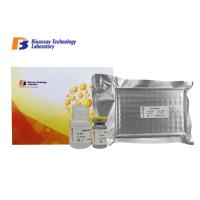| Sign In | Join Free | My himfr.com |
|
| Sign In | Join Free | My himfr.com |
|
| Ask Lasest Price | |
| Brand Name : | BT Lab |
| Model Number : | Cat.No E0351Ra |
| Certification : | CE, ISO9001:2005, MSDS |
| Price : | Negotiation |
| Supply Ability : | Western Union, T/T |
| Delivery Time : | 1-3 business days, bulk order within one week |
High Sensitive Rat Glial Cell Line-derived Neurotrophic Factor ELISA Kit For Research
Cat.No E0351Ra
Standard Curve Range: 0.05ng/ml - 15ng/ml
Sensitivity: 0.02ng/ml
Size: 96 wells
Storage: Store the reagents at 2-8°C. For over 6-month storage refer to the expiration date keep it at -20°C. Avoid repeated thaw cycles. If individual reagents are opened it is recommended that the kit be used within 1 month.
Assay Principle
This kit is an Enzyme-Linked Immunosorbent Assay (ELISA). The plate has been pre-coated with Rat GDNF antibody. GDNF present in the sample is added and binds to antibodies coated on the wells. And then biotinylated Rat GDNF Antibody is added and binds to GDNF in the sample. Then Streptavidin-HRP is added and binds to the Biotinylated GDNF antibody. After incubation unbound Streptavidin-HRP is washed away during a washing step. Substrate solution is then added and color develops in proportion to the amount of Rat GDNF. The reaction is terminated by addition of acidic stop solution and absorbance is measured at 450 nm.
Reagent Provided
| Components | Quantity |
| Standard Solution (16ng/ml) | 0.5ml x1 |
| Pre-coated ELISA Plate | 12 * 8 well strips x1 |
| Standard Diluent | 3ml x1 |
| Streptavidin-HRP | 6ml x1 |
| Stop Solution | 6ml x1 |
| Substrate Solution A | 6ml x1 |
| Substrate Solution B | 6ml x1 |
| Wash Buffer Concentrate (30x) | 20ml x1 |
| Biotinylated Rat GDNF Antibody | 1ml x1 |
| User Instruction | 1 |
| Plate Sealer | 2 pics |
| Zipper bag | 1 pic |
Precautions
Specimen Collection
Serum Allow serum to clot for 10-20 minutes at room temperature. Centrifuge at 2000-3000 RPM for 20 minutes.
Plasma Collect plasma using EDTA or heparin as an anticoagulant. Centrifuge samples for 15 minutes at 2000-3000 RPM at 2 - 8°C within 30 minutes of collection.
Urine Collect by sterile tube. Centrifuge at 2000-3000 RPM for approximately 20 minutes. When collecting pleuroperitoneal fluid and cerebrospinal fluid, please follow the procedures above-mentioned.
Cell Culture Supernatant Collect by sterile tubes when examining secrete components. Centrifuge at 2000-3000 RPM for approximately 20 minutes. Collect the supernatants carefully. When examining the components within the cell, use PBS (pH 7.2-7.4) to dilute cell suspension to the cell concentration of approximately 1 million/ml. Damage cells through repeated freeze-thaw cycles to let out the inside components. Centrifuge at 2000-3000 RPM for approximately 20 minutes.
Tissue Rinse tissues in PBS (pH 7.4) to remove excess blood thoroughly and weigh before homogenization. Mince tissues and homogenize them in PBS (pH7.4) with a glass homogenizer on ice. Thaw at 2-8°C or freeze at -20°C. Centrifuge at 2000-3000 RPM for approximately 20 minutes.
*Sample can't be diluted with this kit. Owing to the the material we use to prepare the kit, the sample matrix interference may falsely depress the specificity and accuracy of the assay.
Reagent Preparation
All reagents should be brought to room temperature before use.
Standard Reconstitute the 120μl of the standard (16ng/ml) with 120μl of standard diluent to generate a 8ng/ml standard stock solution. Allow the standard to sit for 15 mins with gentle agitation prior to making dilutions. Prepare duplicate standard points by serially diluting the standard stock solution (8ng/ml) 1:2 with standard diluent to produce 4ng/ml, 2ng/ml, 1ng/ml and 0.5ng/ml solutions. Standard diluent serves as the zero standard(0 ng/ml). Any remaining solution should be frozen at -20°C and used within one month. Dilution of standard solutions suggested are as follows:
| 8ng/ml | Standard No.5 | 120μl Original Standard + 120μl Standard Diluent |
| 4ng/ml | Standard No.4 | 120μl Standard No.5 + 120μl Standard Diluent |
| 2ng/ml | Standard No.3 | 120μl Standard No.4 + 120μl Standard Diluent |
| 1ng/ml | Standard No.2 | 120μl Standard No.3 + 120μl Standard Diluent |
| 0.5ng/ml | Standard No.1 | 120μl Standard No.2 + 120μl Standard Diluent |
| Standard Concentration | Standard No.5 | Standard No.4 | Standard No.3 | Standard No.2 | Standard No.1 |
| 16ng/ml | 8ng/ml | 4ng/ml | 2ng/ml | 1ng/ml | 0.5ng/ml |
Wash Buffer Dilute 20ml of Wash Buffer Concentrate 30x into deionized or distilled water to yield 500 ml of 1x Wash Buffer. If crystals have formed in the concentrate, mix gently until the crystals have completely dissolved.
Summary
1. Prepare all reagents, samples and standards.
2. Add sample and ELISA reagent into each well. Incubate for 1 hour at 37°C.
3. Wash the plate 5 times.
4. Add substrate solution A and B. Incubate for 10 minutes at 37°C.
5. Add stop solution and color develops.
6. Read the OD value within 10 minutes.
Calculation of Result
Construct a standard curve by plotting the average OD for each standard on the vertical (Y) axis against the concentration on the horizontal (X) axis and draw a best fit curve through the points on the graph. These calculations can be best performed with computer-based curve-fitting software and the best fit line can be determined by regression analysis.

|




